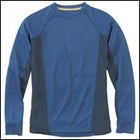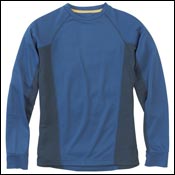There are a lot of variables here, but Ill try to hit the main points.
Polartec Power Dry Crewneck
 Polartec Power Dry Crewneck
Polartec Power Dry CrewneckI find the most useful base layer to be Patagonias Capilene 1 (which used to be called Silkweight). I use it pretty much any time of the year, as a first layer in the winter (with a layer or two over it) and as a single layer even on hot days. It offers good warmth, excellent wicking, and the ability to dry quickly. Plus, its super light and compact. The basic T sells for $36 (www.patagonia.com), a long-sleeve crew for $38.
For a midweight synthetic, I really like Polartec Power Dry. It uses a bi-component knit that puts different fabrics next to your skin and on the outside. Its warm, wicks like mad, and is great in stop-and-start activities such as Alpine skiing or mountain biking. Several makers use it under proprietary labels (Patagonia calls it Capilene 4), but L.L. Bean (www.llbean.com) sells an unadulterated Power Dry Crewneck, long-sleeve, for $32. An excellent buy.
But for me, merino wool is what makes my Gear Guy bunnies hop. I dont use it much during the summer, at least not near sea level, but for fall, spring, and everything in between, it is fabulous. Its warm, comfortable across a wider temperature range than synthetics, feels great next to the skin, keeps you warm even if wet, and wicks well. The secret to the stuff is the deep pockets within the fibers, which trap and hold moisture.
A number of makers now are in the wool market. One of the pioneers is Icebreaker (www.icebreaker.com), a New Zealand company. Its super-useful, lightweight Skin200 Oasis Crewe is $60; the midweight Bodyfit260 Long Sleeve Crewe is $70. SmartWool (www.smartwool.com) also uses merino wool in a base layer line, selling a microweight short-sleeve crew for $50. Patagonia also makes wool base layers, such as its moderately heavy Wool 3 line, which includes the Zip-Neck T for $98.
Price is the knock on wool. But it is exceedingly tough, so will likely outlast most synthetics. And for comfort, its nearly unbeatable. The only problem is that if it gets wetfrom sweat or rain or a dunk off the kayakits slower to dry than synthetics. Itll still keep you warm, though.
Get more advice from the Gear Guy as he picks this seasons top gifts in Youll probably find a few things to put on your own wish list, too.


